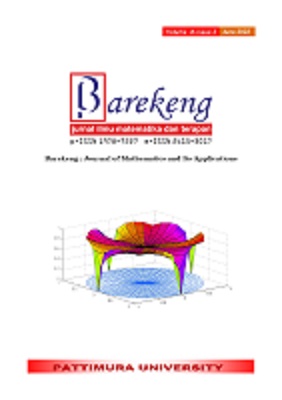ROBUST CLUSTERING OF COVID-19 PANDEMIC WORLDWIDE
Abstract
COVID-19 pandemic is described as the most challenging crisis that humans have faced since World War II. From December 2019 until August 2021 based on the dataset provided by WHO, globally 219 countries in the world are affected by this virus. There are 205.338.159 cases cumulative total and 4.333.094 death cumulative total caused by this virus. In this paper, the data of 219 countries are analyzed using a robust clustering method namely K-Medoids cluster analysis. Based on the result, 219 countries in the world can be divided into five clusters based on four COVID-19-related variables, i.e. the number of cases cumulative total, death cumulative total, positive cases per capita, and case fatality rate. The distribution of the countries in five clusters was as follows; the first cluster contained 48 countries, the second cluster contained 3 countries, the third and fourth clusters contained 16 and 89 countries respectively, and the last cluster contained 63 countries. The largest cluster is the fourth one, containing countries that form a cluster with a centroid below the world average, and the smallest cluster is the second cluster with the high cases in all attributes, consisting of the USA, India, and Brazil.
Downloads
References
M. Ciotti, M. Ciccozzi, A. Terrinoni, W. C. Jiang, C. Bin Wang, and S. Bernardini, “The COVID-19 pandemic,” Crit. Rev. Clin. Lab. Sci., vol. 57, no. 6, pp. 365–388, 2020.
N. Shrestha et al., “The impact of COVID-19 on globalization,” One Heal., vol. 11, p. 100180, 2020.
J. F. Hair, W. C. Black, and R. E. Anderson, Multivariate Data Analysis: Pearson New International Edition, 7th ed. England: Pearson Education Limited, 2014.
R. A. Johnson and D. W. Wichern, Applied Multivariate Statistical Analysis, 6th ed. Pearson Education Limited, 2014.
S. D. A. Larasati, K. Nisa, and N. Herawati, “Robust Principal Component Trimmed Clustering of Indonesian Provinces Based on Human Development Index Indicators,” J. Phys. Conf. Ser., vol. 1751, no. 1, pp. 0–8, 2021.
R. Shang, B. Ara, I. Zada, S. Nazir, Z. Ullah, and S. U. Khan, “Analysis of Simple K- Mean and Parallel K- Mean Clustering for Software Products and Organizational Performance Using Education Sector Dataset,” Sci. Program., vol. 2021, 2021.
C. Wu et al., “K -Means Clustering Algorithm and Its Simulation Based on Distributed Computing Platform,” Complexity, vol. 2021, 2021.
B. Suharjo and M. S. U. Utama, “K-Means Cluster Analysis of Sex, Age, and Comorbidities in the Mortalities of Covid-19 Patients of Indonesian Navy Personnel,” JISA(Jurnal Inform. dan Sains), vol. 4, no. 1, pp. 17–21, Jun 2021.
X. Jin and J. Han, “K-Means Clustering,” in Encyclopedia of Machine Learning and Data Mining, C. Sammut and G. I. Webb, Eds. Boston, MA: Springer US, 2017, pp. 695–697.
P. Devi and K. Kaur, “A Robust Cluster Head Selection Method Based on K-Medoids Algorithm to Maximize Network Life Time and Energy Efficiency for Large WSNs,” Int. J. Eng. Res. Technol., vol. 3, no. 5, pp. 1430–1432, 2014.
M. A. Ramdani and S. Abdullah, “Application of partitioning around medoids cluster for analysis of stunting in 100 priority regencies in Indonesia,” J. Phys. Conf. Ser., vol. 1722, no. 1, p. 012097, Jan 2021.
S. Vishwakarma, P. S. Nair, and D. S. Rao, “A Comparative Study of K-means and K-medoid Clustering for Social Media Text Mining,” Int. J., vol. 2, no. 11, pp. 297–302, 2017.
R. P. A, K. S. Vani, J. R. Devi, and D. . N. Rao, “An Efficient Density based Improved K- Medoids Clustering algorithm,” Int. J. Adv. Comput. Sci. Appl., vol. 2, no. 6, 2012.
E. Schubert and P. J. Rousseeuw, “Faster k-Medoids Clustering: Improving the PAM, CLARA, and CLARANS Algorithms,” in Lecture Notes in Computer Science (including subseries Lecture Notes in Artificial Intelligence and Lecture Notes in Bioinformatics), Oct 2019, vol. 11807 LNCS, pp. 171–187.
R. K. Dinata, S. Retno, and N. Hasdyna, “Minimization of the Number of Iterations in K-Medoids Clustering with Purity Algorithm,” Rev. d’Intelligence Artif., vol. 35, pp. 193–199, 2021.
G. Ghufron, B. Surarso, and R. Gernowo, “The Implementations of K-medoids Clustering for Higher Education Accreditation by Evaluation of Davies Bouldin Index Clustering,” J. Ilm. Kursor, vol. 10, no. 3, pp. 119–128, Jul 2020.
K. Nakagawa, M. Imamura, and K. Yoshida, “Stock price prediction using k-medoids clustering with indexing dynamic time warping,” Electron. Commun. Japan, vol. 102, no. 2, pp. 3–8, Feb 2019.
R. Hajlaoui, E. Alsolami, T. Moulahi, and H. Guyennet, “An adjusted K-medoids clustering algorithm for effective stability in vehicular ad hoc networks,” Int. J. Commun. Syst., vol. 32, no. 12, p. e3995, Aug 2019.
I. H. Rifa, H. Pratiwi, and R. Respatiwulan, “Clustering Of Eartquake Risk in Indonesia Using K-Medoids and K-Means Algorithms,” MEDIA Stat., vol. 13, no. 2, pp. 194–205, Dec. 2020.
S. Gultom, S. Sriadhi, M. Martiano, and J. Simarmata, “Comparison analysis of K-Means and K-Medoid with Ecluidience Distance Algorithm, Chanberra Distance, and Chebyshev Distance for Big Data Clustering,” IOP Conf. Ser. Mater. Sci. Eng., vol. 420, no. 1, 2018.
Authors who publish with this Journal agree to the following terms:
- Author retain copyright and grant the journal right of first publication with the work simultaneously licensed under a creative commons attribution license that allow others to share the work within an acknowledgement of the work’s authorship and initial publication of this journal.
- Authors are able to enter into separate, additional contractual arrangement for the non-exclusive distribution of the journal’s published version of the work (e.g. acknowledgement of its initial publication in this journal).
- Authors are permitted and encouraged to post their work online (e.g. in institutional repositories or on their websites) prior to and during the submission process, as it can lead to productive exchanges, as well as earlier and greater citation of published works.






1.gif)



